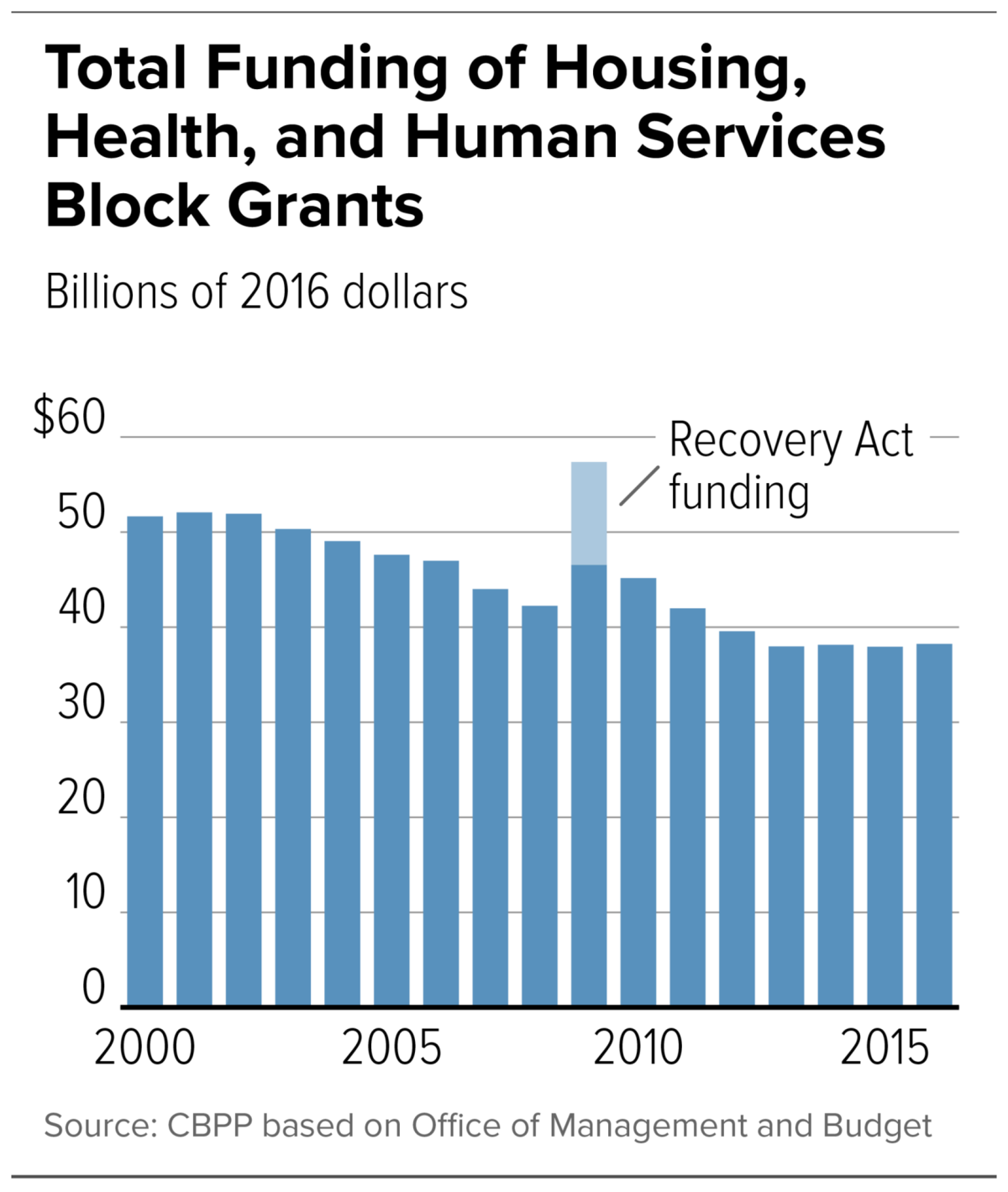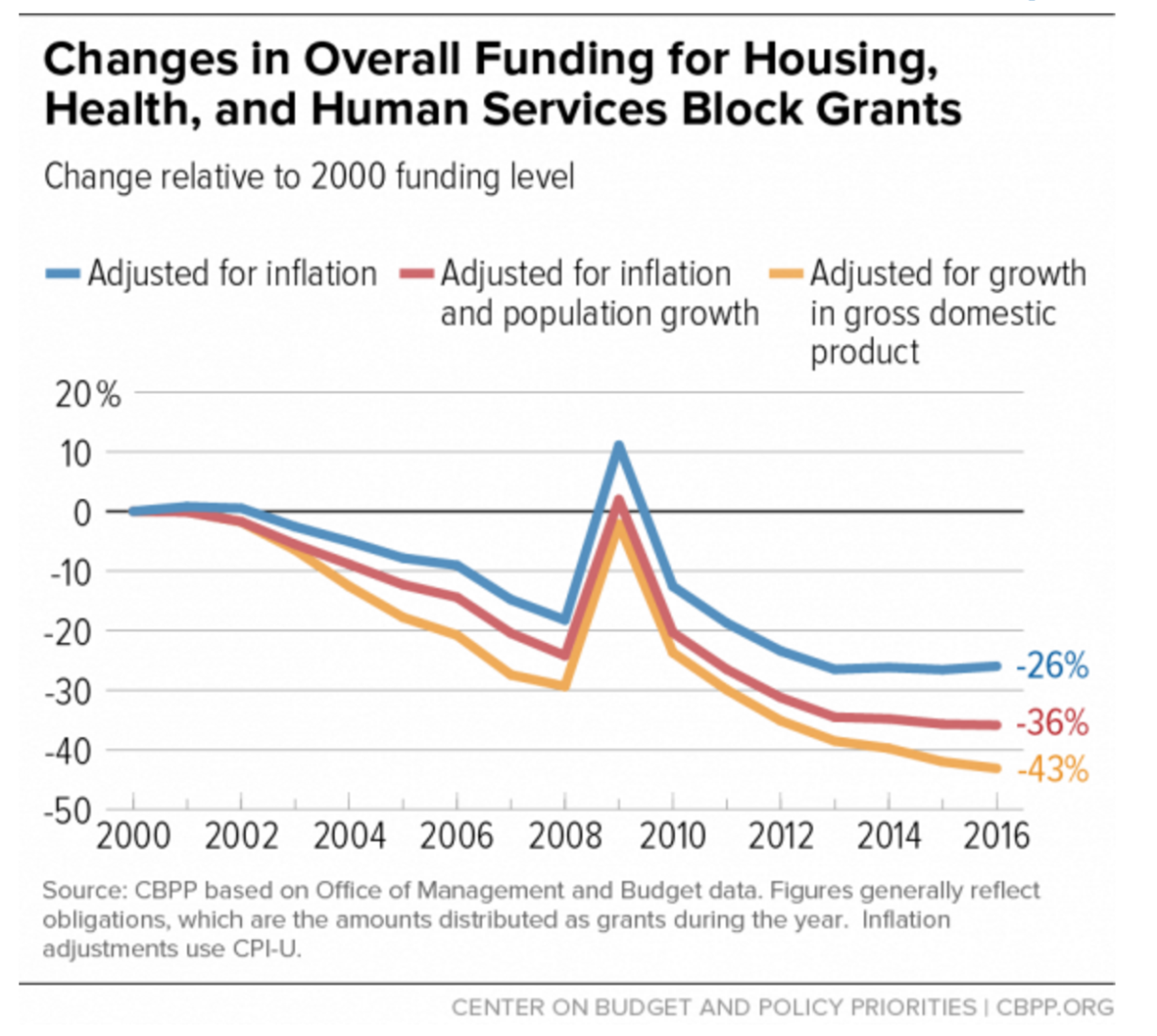Block grants are just budget cuts in disguise — and the targets are antipoverty programs

- Share via
The most popular panacea offered by conservatives for the supposed burden of federal funding that comes with strings attached is the "block grant." The idea is that states and localities know best how to serve their citizens — especially their disadvantaged citizens — so the feds should just give them bundles of money for social programs and let them decide how to spend it. Much better than the government trying to manage these programs from far-off Washington, D.C.
Block-grant proposals almost always include assurances that funding won't be reduced as a result. But block grants are a poisoned chalice, as a new study by the progressive-leaning Center on Budget and Policy Priorities shows. Of the 13 major housing, health and social services block-granted programs launched in recent decades, 11 suffered funding cuts since their inception and 10 since 2000. Some have lost well more than half their funding. The paper is an update of a 2014 report, but it may be even more relevant in this political year.
"Block grants' basic structure makes them especially vulnerable to funding reductions over time," the CBPP found. Although the grants are typically tied to requirements that states maintain the programs at historical levels, it's easy for them to divert the money for other purposes, including filling in their general budgetary needs.
Block grants' basic structure makes them especially vulnerable to funding reductions over time.
— Center on Budget and Policy Priorities
Block grants figure prominently among the policy nostrums offered by the GOP candidates for president (when the honor of each others' wives is off the table, that is).
Donald Trump's healthcare plan includes block-granting Medicaid to the states: "The state governments know their people best and can manage the administration of Medicaid far better without federal overhead." (We think he means "oversight," not "overhead," but let it go.) "States will have the incentives to seek out and eliminate fraud, waste and abuse to preserve our precious resources," he continues. Ted Cruz wants to block-grant federal education funding to "return education to those who know our students best: parents, teachers, local communities, and states."

These ideas draw a line from House Speaker Paul Ryan, who has long favored packaging 11 antipoverty programs into a single block grant. As Jared Bernstein, former economic advisor to Vice President Joe Biden, observed when this idea first came up, it "would gut the counter-cyclicality of the federal safety net and make the programs an easy target for cuts."
The flaws in these arguments are obvious. State and local program standards vary widely, often without any relationship to residents' needs. Consider Medicaid, which is funded jointly by the federal and state governments. Traditional Medicaid is a straightforward antipoverty program aimed at providing healthcare services to needy families with children. (The expansion authorized under the Affordable Care Act is broader.)
States can set income ceilings for Medicaid eligibility themselves, within a wide range. In Alabama, which has not expanded Medicaid, parents are excluded if they earn more than 13% of the federal poverty line, or about $1,500 a year, and childless adults are excluded entirely; in California and other states that accepted the expansion, adults are eligible with earnings of up to $15,800.

The CBPP study observes that the real problem with block grants is their inflexibility. When a program is converted from federal funding to block grants, the initial grant is typically pegged to the most recent spending on the program, but there's rarely any mechanism to revisit the funding as conditions change or in light of population growth.
That's why the resources deteriorate over time. Programs that must be especially flexible are in real trouble. That's why proposals to block-grant food stamps (the program is formally known as the Supplemental Nutrition Assistance Program, or SNAP), are especially dangerous. SNAP, as currently constituted, automatically expands during economic slumps. If it were block-granted, then funding would lag behind need until and unless Congress stepped in with new appropriations.
The best evidence of the threat to social programs from block-granting comes from the Temporary Assistance for Needy Families, the government's basic welfare program, which replaced the old Aid to Families with Dependent Children in 1996. "After adjusting for inflation," CBPP found, "federal TANF funding has fallen by 32 percent, even as the U.S. population has grown." In 1996, the last year of AFDC, 68 of every 100 poor families with children received assistance. By 1998, the figure was 51 and by 2014, only 23 of every 100 needy families received help.
Think of that the next time you hear that block-granting is more efficient or effective in addressing social needs. It's only more effective at saving money in the federal budget and ensuring that the government becomes less relevant to the needy.
Keep up to date with Michael Hiltzik. Follow @hiltzikm on Twitter, see his Facebook page, or email [email protected].
Sign up for Essential California
The most important California stories and recommendations in your inbox every morning.
You may occasionally receive promotional content from the Los Angeles Times.








